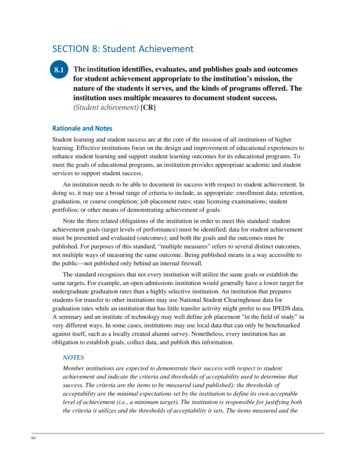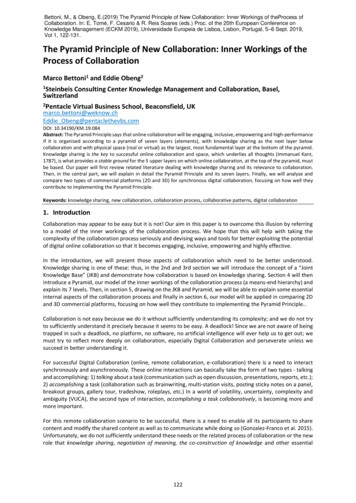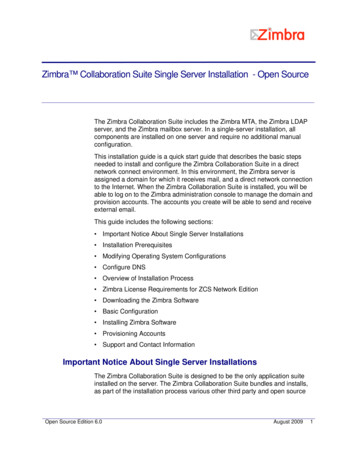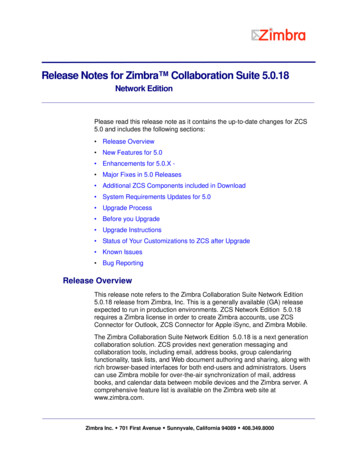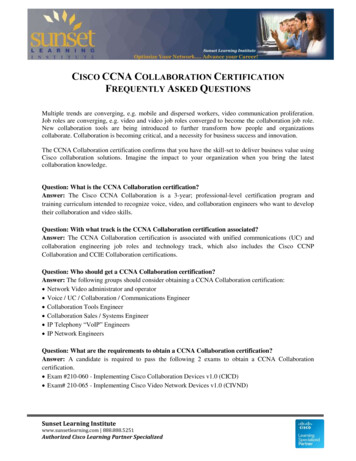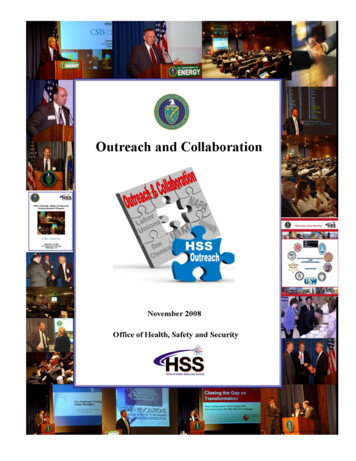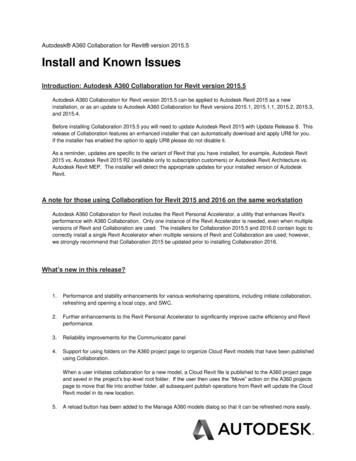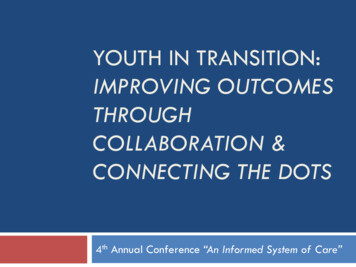
Transcription
YOUTH IN TRANSITION:IMPROVING OUTCOMESTHROUGHCOLLABORATION &CONNECTING THE DOTS4th Annual Conference “An Informed System of Care”
Session OutcomesCollective Impact Children’s Cabinet Governor’s Coordinating Council Aging Out of Foster Care & Risk ofHomelessness IPPEYH Strategic Plan How to Connect Locally
Collective Impact Common Agenda All participants must agree on the primary goalsShared Measurement Agree Mutually Reinforced Activities Eachplan on ways success will be measured and reportedstakeholder’s efforts must fit into an overarchingContinuous Communications Meetingsagenda need to happen regularly with a structuredBackbone Support Organization
The Virginia Children’s Cabinet Established by Executive Order 21 To “develop and implement a comprehensive policyagenda related to the education, health, safety, andwell-being of youth throughout the Commonwealth” Subset of the Governor’s Cabinet, with goal ofinternally aligning agency priorities and programs Focus is on prenatal through age 21
Children’s Cabinet Structure Leadership Co-Chaired by Secretary of Education Anne Holtonand Secretary of Health and Human Resources BillHazel Membership Lt. Governor Ralph Northam First Lady Dorothy McAuliffe Secretary of Commerce & Trade Maurice Jones Secretary of Public Safety & Homeland SecurityBrian Moran
Children’s Cabinet PrioritiesExecutive Order 21 establishes five priority areas for theChildren’s Cabinet:1. Beyond the barriers. Schools in high-poverty communities face numeroussystemic societal barriers2. Raising the foundation. High quality early child care, increased access topre-K, and educational programs3. Access to basics. Access to healthcare, housing, and proper nutrition
Children’s Cabinet Priorities4. Triumph over transitions. Services for youth who are transitioning out ofVirginia’s juvenile justice, mental health, and fostercare systems5. Working parents, building families. Policies and services that encourage workforcedevelopment efforts for parents through education,credential training, career development, andemployment
Creating a Children’s Agenda Stakeholder Input StateAgencies Community Organizations Advocates Community Outreach Taking the Cabinet on the RoadStrategic Plan CaseyFamily Programs
Triumph Over TransitionsHousing Stability
Governor McAuliffe IssuesExecutive Order 32 Virginia’s Housing Policy Agenda Purpose of the Housing Policy Agenda:Identify & implement actions to enable quality, affordablehousing which will strengthen families and communities andfoster economic growth
Virginia’s Housing Policy Agenda Key Components Prioritizethe most urgent areas of housing & homelessprogram needs Offer advise and recommendations that address: Homelessness,particularly among veterans, young adultsand children Rapid re-housing strategies Housing opportunities for individuals with disabilities andspecial needs Appropriate housing options for an aging demographic
Governor’s Initiative on HomelessnessGovernor’sCoordinating CouncilOn mmitteeGovernor’sAdvisory CommitteeOn HomelessnessEnding VeteranHomelessnessCommitteeInteragencyPartnership toPrevent & EndYouthHomelessness
Successful Transitions Department of Social Services and Department ofJuvenile Justice CollaborationFostering ConnectionsInteragency Partnership to Prevent and End YouthHomelessness
DSS & DJJ Collaboration Issue DJJand DSS have identified a gap in the continuum ofservices for juveniles in foster care who are committedto DJJ and have worked with stakeholders to identifysolutions. Purpose of the MOA Toidentify the roles and responsibilities of the locallyoperated department of social services (LDSS) and DJJ To serve the best interest of juveniles who arecommitted to DJJ and who were in the custody of LDSSimmediately prior to commitment
Fostering Connections Movement to extend Foster Care and AdoptionAssistance to age 21Age of independence is closer to the late 20’s than 18Worse outcomes for children aging out of foster careincluding higher rate of homelessness, criminal activity,psychiatric hospitalizations, earlier pregnancies andreliance on the public welfare systemLower rates of graduation from high school or anyhigher education settingSignificantly lower annual incomes
Foster Care and Adoption Profile
Permanency Rates
INTERAGENCYPARTNERSHIP TOPREVENT & END YOUTHHOMELESSNESS
Preventing & EndingYouth HomelessnessMissionTo leverage state resources moreeffectively; maximize the effectiveness ofstate services and resources for youthexperiencing or at risk of experiencinghomelessness; and realize efficienciesthrough enhanced coordination and sharedresources among state agencies.
Preventing & EndingYouth HomelessnessVisionA community where no youth ishomeless and every youth issupported by stable housing,permanent connections, education oremployment and social andemotional well-being
Strategic Plan
Paul McWhinney, ChairDepartment of Social ServicesPam KestnerOffice of the Secretary of Health and Human ResourcesKathy RobertsonDepartment of Housing and Community DevelopmentAnna AntellOffice of Comprehensive ServicesNichele CarverDepartment of Housing and Community DevelopmentSusie ClareOffice of Comprehensive ServicesJackie CowanUnited Methodist HomeBruce CruserVirginia Department of Criminal Justice ServiceAshley HarrellDepartment of Medical Assistance ServicesLelia HopperCourt Improvement Program – Supreme CourtKelly King HorneHomewardMalcom KingDepartment of Behavioral Health and Developmental ServicesMichelle KirbyOffice of the Secretary of EducationMakita LewisDepartment of Social ServicesJanet LungDepartment of Behavioral Health and Developmental ServicesChristie MarraVirginia Poverty Law CenterLetha Moore-JonesDepartment of Social ServicesMelissa O’NeilDepartment of Criminal Justice ServicesPat PoppProject HOPE /William & MaryAllyson RobertsGreat Expectations/Virginia Community College SystemErika SchmaleHomewardMichael ShankDepartment of Behavioral Health and Developmental ServicesTerri StottDepartment of Juvenile JusticeRachel StrawnGreat Expectations/Virginia Community College SystemKimberly TuckerSt. Joseph’s VillaMary “Alex” WagamanVCU-School of Social WorkAmy WoolardVoices for VA’s Children
Strategic Plan 2015-2017Target PopulationLow income young people, ages 14-24, whoare homeless or at-risk of becominghomeless. This target population includesthose youth involved in foster care or juvenilejustice systems. It may also include youth whoare not enrolled in or at risk of dropping outof an educational institution.
Core Outcomes StableHousing Permanent Connections Education & Employment Social-emotional well-being
Definitions of HomelessnessHUDA person is considered homeless only when s/helives: On the street, In a place not meant for human habitation (e.g.cars, campsites, and abandoned buildings),in an emergency shelter, In transitional or supportive housing (for peoplecoming from streets or shelter), or In any of the above places prior to entering ahospital/institution for short-term (30 days orless).A person is also considered homeless if he/she isbeing Evicted within a week from a private dwelling,or Discharged within a week from an institutionwhere they stayed long term, 31 days or more,and a housing plan is not provided as part ofdischarge planning.McKinney-Vento Act Homeless children are "individuals who lack a fixed,regular, and adequate nighttime residence." The actprovides examples of children who would fall under thisdefinition:Children and youth sharing housing due to loss ofhousing, economic hardship or a similar reasonChildren and youth living in motels, hotels, trailer parks,or camp grounds due to lack of alternativeaccommodationsChildren and youth living in emergency or transitionalshelters Children and youth abandoned in hospitals Children and youth awaiting foster care placement Children and youth whose primary nighttime residenceis not ordinarily used as a regular sleepingaccommodation (e.g. park benches, etc)Children and youth living in cars, parks, public spaces,abandoned buildings, substandard housing, bus or trainstationsMigratory children and youth living in any of the abovesituations
Goal 1Increase stable Housing forYouth who are or at risk ofExperiencing Homelessness
OBJECTIVES Identify youth who are experiencing homelessness or atrisk homelessnessIdentify housing options and relevant best practicesEnsure every youth exiting foster care or juvenile justicehas a verified discharge/ transition plan for permanenthousing for at least six months post exitImplement best practice to meet the housing needs of thetarget populationDevelop strategies for working with youth with uniquebarriers to housing, including but not limited to,undocumented youth, LGBT youth, and youth with legalbarriers to accessibility. (e.g. housing barrier crimes,poor credit reports, etc.)Provide youth with information about their housing rights
Goal 2Build and Enhance PermanentConnections for the TargetPopulation
OBJECTIVES Assess fidelity of Virginia’s child servicespractice modelImprove support and training acrossdisciplinesThrough the transition plans of the VirginiaDepartment of Social Services and theDepartment of Juvenile Justice enhance nonsystem natural supports (coaches, teachers,extended family, etc.)Support foster care to age 21
Goal 3Increase Access to and Successin Education and Employmentfor the Target Population
OBJECTIVES Incorporate peer support and outreach, topromote education and employmentCreate Youth on the Move social mediapackage (website with apps)Educate stakeholders and service providerson resourcesIdentify corporate sponsorship andapprenticeship opportunities for job trainingand placement
OBJECTIVES Establish Single Points of Contact (SPOC)s atinstitutions of higher educationCoordinate with “mainstream” workforcesystems and private employersIdentify best practices that address barriersto employment for homeless LGBTQ youth,youths with criminal records, and youths atincreased risk due to immigration statusExplore expanding Great Expectations toserve youth identified as experiencinghomelessness, or at risk of homelessnessincluding those identified by local McKinneyVents Liaisons
Goal 4Increase Social and EmotionalFunctioning of the TargetPopulation
OBJECTIVES Weave strengths and evidence basedpractices across agencies (system focus)Train Workforce with renewed focus onstrengths and evidence based on practiceDeveloping, supporting, and empoweringyouth resiliency through youth engagement,training and skill development
Connecting LocallyIPPEYH Work Group Participation Involvement in Continuum of Care (CoC) Project Hope Great Expectations Other Ideas? Article: Families at the Nexus of Housing and ChildWelfare – November 2014, First Focus; State PolicyAdvocacy & Reform CenterNexus of Housing and Child Welfare
ContactPamela Kestner, MSWSpecial Advisor on Families, Children and PovertyOffice of the Secretary of Health and Human Resourcespamela.kestner@governor.virginia.govPaul D. McWhinney, MSW, ACSW, MAPADeputy Commissioner for ProgramsVirginia Department of Social ServicesPaul.mcwhinney@dss.virginia.gov
Questions & Answers
program needs Offer advise and recommendations that address: . VCU-School of Social Work . Amy Woolard. Voices for VA's Children . Strategic Plan 2015 -2017 . . Pamela Kestner, MSW : Special Advisor on Families, Children and Poverty . Office of the Secretary of Health and Human Resources . pamela.kestner@governor.virginia.gov.


